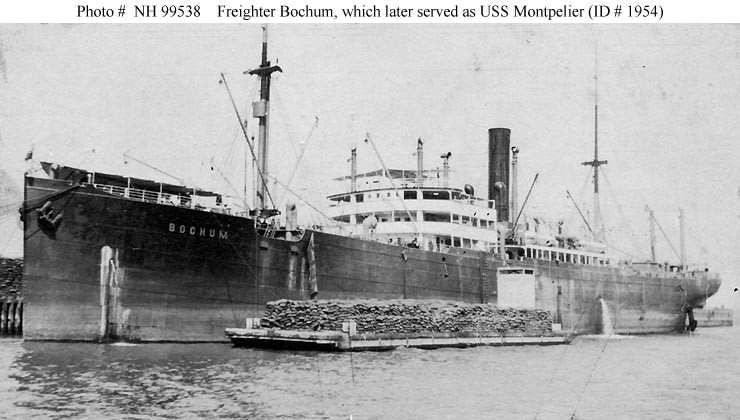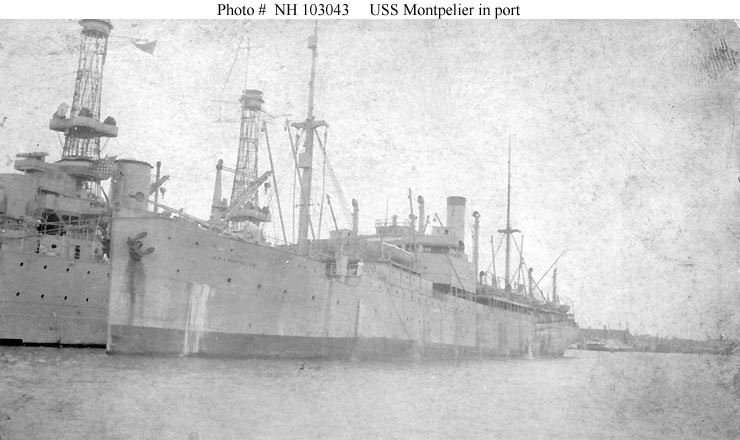Montpelier I (Screw Steamer)

(Screw Steamer: displacement 16,000; length 477'9"; beam 58'; draft 26'6" (aft); speed 12 knots; armament 1 5-inch, 1 3-inch)

I
The first Montpelier retained the name that the ship carried at the time of her transfer from the War Department; the second Montpelier (CL-57) and the third Montpelier (SSN-765) were named for the city in Vermont.
Bochum, a large freighter, was built in 1912 by Aktiengesellschaft Neptun, Rostock, Germany for the German-Australian Line of Hamburg. When World War I broke out in August 1914, she took refuge at Manila and was interned there. She was seized by the U.S. Government on 7 April 1917 and turned over to the U.S. Shipping Board for operation. After repairs of damage to her main engine, which had been sabotaged by her crew, Bochum sailed from Manila with cargo on 19 June 1917.
Bochum was renamed Montpelier in around August 1917. Montpelier was inspected in the Twelfth Naval District (San Francisco, Calif.) on 24 August 1917 for possible Navy use and was assigned the identification number (Id.No.) 1954. In October 1917, the freighter was transferred to the control of the War Department which had her fitted-out as a horse transport.
After the end of hostilities in November 1918, Montpelier was one of approximately 45 large freighters converted to transport American troops home from Europe. Transferred to the Navy for operation, Montpelier (Id.No.1954) was commissioned at Brooklyn, N.Y., on 12 March 1919, Lt. Comdr. Hiram Dixon, USNRF, in command.
Montpelier departed New York on 21 April 1919, bound for France on the first of her four transatlantic Navy trooping voyages. The ship arrived at Bordeaux on 4 May and moored at the American Docks, Bassens, the following day. On 11 May, she embarked 2,209 troops, 60 officers, and 2 YMCA representatives and immediately sailed for Philadelphia, where she arrived on 25 May. After a rapid turnaround, the transport sailed from Philadelphia on 29 May for St. Nazaire, where she arrived on 10 June. In the evening, 2,071 troops and 25 officers came on board, and the ship sailed for New York at 1:42 a.m. on 11 June. After delivering her passengers at New York on 24 June she moved to the Portsmouth Navy Yard for a few days of maintenance.
Montpelier departed Portsmouth on 1 July 1919 and arrived at St. Nazaire on 13 July. Her contingent of troops arrived on board in the evening of 16 July and the ship sailed at daybreak on 17 July for the Army Piers at Hoboken, N.J., where she disembarked her returning veterans on 29 July. The converted freighter departed Hoboken on 5 August and anchored in the roadstead at Brest on 16 August. The self-propelled water barge Rintintin, which also served as a tender to bring troops to the transports anchored at Brest, brought her a load of fresh water on 26 August, and in the morning of 28 August, 1,091 troops and 28 officers were brought out on board lighters. Montpelier immediately got underway for New York and delivered her last passengers to the Army's Bush Terminal, Brooklyn, on 10 September.
Montpelier steamed from New York to Norfolk, Va., (13-14 September 1919), where she was decommissioned at noon on 8 October 1919 and handed over to the U.S. Shipping Board (USSB).
Extensively reconditioned by the USSB, Montpelier subsequently enjoyed a long career as a merchant ship. She remained under Shipping Board ownership as Montpelier until 1927, when the American-Hawaiian Line purchased her and renamed her Nevadan. She served in 1943-44 under Lend-Lease as the Soviet Yan Tomp. Reverting to her previous name, Nevadan, she was scrapped at San Francisco in 1949.
Stephen S. Roberts


